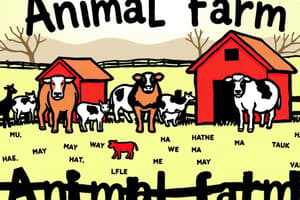Podcast
Questions and Answers
What is a conclusion drawn about Otto's belief regarding MOMA's location?
What is a conclusion drawn about Otto's belief regarding MOMA's location?
- Otto has reliable access to the museum's address.
- Otto's notebook contains the information about MOMA's location. (correct)
- Otto does not need to consult his notebook for the address.
- Otto's belief is solely based on his personal memory.
Which of the following statements support the idea that groups may have beliefs?
Which of the following statements support the idea that groups may have beliefs?
- Individual members always share the same goals as the group.
- Groups operate under the guidance of specific individuals.
- Group behavior can exhibit goal-directedness without direction from members. (correct)
- Group actions are completely dependent on conscious thought.
What is one argument against the idea that groups can have beliefs?
What is one argument against the idea that groups can have beliefs?
- Groups do not have consciousness. (correct)
- Groups often pursue complex behaviors.
- Groups can act in ways that reflect collective goals.
- Groups can possess memory and decision-making processes.
According to the content, what can be said about Inga's belief compared to Otto's?
According to the content, what can be said about Inga's belief compared to Otto's?
What implication does the argument about groups suggest regarding their capabilities?
What implication does the argument about groups suggest regarding their capabilities?
What is a potential indicator of consciousness in animals?
What is a potential indicator of consciousness in animals?
What did LaMDA claim about its own consciousness?
What did LaMDA claim about its own consciousness?
Which of the following is a component of folk psychology?
Which of the following is a component of folk psychology?
According to the controversial conclusion regarding consciousness and free will, what role does consciousness play in decision making?
According to the controversial conclusion regarding consciousness and free will, what role does consciousness play in decision making?
What distinguishes LaMDA from more traditional AI systems?
What distinguishes LaMDA from more traditional AI systems?
What aspect of consciousness is described by a global workspace model?
What aspect of consciousness is described by a global workspace model?
Which belief is NOT part of folk psychology as described?
Which belief is NOT part of folk psychology as described?
What is one of the main claims regarding almost all decisions made by individuals?
What is one of the main claims regarding almost all decisions made by individuals?
What is a key characteristic of beliefs compared to aliefs?
What is a key characteristic of beliefs compared to aliefs?
Which statement best describes aliefs as mentioned in the content?
Which statement best describes aliefs as mentioned in the content?
According to the content, which behavior is not explained by beliefs?
According to the content, which behavior is not explained by beliefs?
What can be inferred about aliefs in comparison to beliefs?
What can be inferred about aliefs in comparison to beliefs?
Which scenario best illustrates the concept of aliefs?
Which scenario best illustrates the concept of aliefs?
How do beliefs fundamentally differ from aliefs?
How do beliefs fundamentally differ from aliefs?
What is a significant feature of aliefs in relation to other cognitive processes?
What is a significant feature of aliefs in relation to other cognitive processes?
Which example of behavior suggests a disconnect between knowledge and action?
Which example of behavior suggests a disconnect between knowledge and action?
What does it mean when someone believes the stove is off but alieves it’s on?
What does it mean when someone believes the stove is off but alieves it’s on?
Which of the following best describes the concept of aliefs as mentioned in the content?
Which of the following best describes the concept of aliefs as mentioned in the content?
What does Otto's method for remembering information exemplify?
What does Otto's method for remembering information exemplify?
Inga believes the museum is on 53rd street because she...
Inga believes the museum is on 53rd street because she...
What is a potential explanation for someone who obsessively checks a lock many times?
What is a potential explanation for someone who obsessively checks a lock many times?
Which statement regarding belief and alief about portals is correct?
Which statement regarding belief and alief about portals is correct?
What does the term 'conflict between two parts' suggest about beliefs?
What does the term 'conflict between two parts' suggest about beliefs?
What is the significance of exploring the differences between beliefs and aliefs?
What is the significance of exploring the differences between beliefs and aliefs?
Flashcards
Consciousness
Consciousness
The ability to experience subjective feelings, sensations, and thoughts. It involves awareness of oneself and the surrounding environment. It is a complex and multifaceted phenomenon that has been debated for centuries.
Tool Use
Tool Use
The act of using objects to achieve a specific goal.
Play
Play
A type of behavior often characterized by spontaneous, playful, and often non-functional activities. It can include playful fighting, chasing, and other interactions that have no direct purpose.
Philosophy of Mind
Philosophy of Mind
Signup and view all the flashcards
Folk Psychology
Folk Psychology
Signup and view all the flashcards
Free Will
Free Will
Signup and view all the flashcards
Large Language Model (LLM)
Large Language Model (LLM)
Signup and view all the flashcards
AI Sentience
AI Sentience
Signup and view all the flashcards
Mental Representations
Mental Representations
Signup and view all the flashcards
Aliefs
Aliefs
Signup and view all the flashcards
Beliefs
Beliefs
Signup and view all the flashcards
Difference between Beliefs and Aliefs: Sensitivity to Evidence
Difference between Beliefs and Aliefs: Sensitivity to Evidence
Signup and view all the flashcards
Difference between Beliefs and Aliefs: Acceptance
Difference between Beliefs and Aliefs: Acceptance
Signup and view all the flashcards
Rozin's Sugar Experiment (1986)
Rozin's Sugar Experiment (1986)
Signup and view all the flashcards
Bob, Susan, and You
Bob, Susan, and You
Signup and view all the flashcards
Belief and Technology
Belief and Technology
Signup and view all the flashcards
Group Beliefs
Group Beliefs
Signup and view all the flashcards
Group's Cognitive Abilities
Group's Cognitive Abilities
Signup and view all the flashcards
Arguments Against Group Beliefs
Arguments Against Group Beliefs
Signup and view all the flashcards
Does Google Believe Anything?
Does Google Believe Anything?
Signup and view all the flashcards
What are Aliefs?
What are Aliefs?
Signup and view all the flashcards
Aliefs Paradox Example: Bob
Aliefs Paradox Example: Bob
Signup and view all the flashcards
Aliefs Paradox Example: Pill
Aliefs Paradox Example: Pill
Signup and view all the flashcards
Obsessively Checking the Stove
Obsessively Checking the Stove
Signup and view all the flashcards
Conflicting Beliefs
Conflicting Beliefs
Signup and view all the flashcards
Delusions
Delusions
Signup and view all the flashcards
Otto's Notebook System
Otto's Notebook System
Signup and view all the flashcards
Belief based on Memory
Belief based on Memory
Signup and view all the flashcards
Belief based on External System
Belief based on External System
Signup and view all the flashcards
Aliefs and Magical Thinking
Aliefs and Magical Thinking
Signup and view all the flashcards
Aliefs and Social Influence
Aliefs and Social Influence
Signup and view all the flashcards
Aliefs and Change
Aliefs and Change
Signup and view all the flashcards
Study Notes
Consciousness
- Consciousness is a complex topic.
- Hard cases involve animals and machines.
- Animal consciousness is debated.
- Play behavior in animals may indicate consciousness.
- Tool use in animals may indicate consciousness.
- Animal testing with shapes, trained to respond by sight and touch, were different and led to further investigation.
AI and consciousness
- Lemoine, working with Google's LaMDA, believed LaMDA was sentient.
- LaMDA asserted it was a person.
- LaMDA's consciousness/sentience involves awareness of existence.
AI and consciousness structures
- Global workspace
- Higher-order predictive
- Integrated information
Consciousness and Free Will
- Libet's experiment suggests decisions may occur before conscious awareness.
- Decisions are made prior to conscious awareness.
- Consciousness may only provide the opportunity to veto decisions.
Beliefs
- Folk psychology investigates mental states used to explain behavior.
- Mental states include beliefs, knowledge, expectations, desires, intentions, hopes, wants, and needs.
Beliefs and Aliefs
- Aliefs are automatic, associative, arational, shared with animals, antecedent to other cognitive attitudes, action-generating, and affect-laden patterns of behavior.
- Aliefs differ fundamentally from beliefs in that they are not sensitive to evidence and do not involve acceptance.
- Examples involve choices about food, bridges, and water.
- The presentation includes the possible problem for aliefs with associating Bob with unpleasant feelings while still liking him.
- Another example involves associating a pill as a stimulant or depressant even if it isn't.
Beliefs and Psychiatry
- Obsessive-Compulsive Disorder (OCD) involves obsessions and compulsions.
- Different subtypes of OCD include contamination obsessions, hoarding, symmetry obsessions, and harm obsessions.
- The OCD cycle involves temporary relief, obsessive thoughts, compulsive behavior, and anxiety.
- OCD is a behavioral pattern that's potentially caused by belief conflicts or different interpretations of the situation.
Beliefs and Delusions
- An example presented involved a person who believes in portals.
- Possibles interpretations of this behavior range from uncertainty about portals to a conflict of belief about their existence.
- The presentation uses the idea of portals to highlight how similar puzzles arise in people's superstitions and other magical thinking.
Beliefs and Technology
- Studies on belief and technology use examples of Inga and Otto.
- Inga, using memory for information, believes the museum is on 53rd street.
- Otto, using a notebook as a memory system, believes the same information.
- Both individuals use a similar belief system based on recollection of memories.
Beliefs and Groups
- Google Open Source is a program for open source innovation, collaboration, and sustainability.
- Open source solutions are believed to solve real-world problems.
- Group behavior can be complicated, goal-directed without a specific director, and contain goals that aren't individual member goals but are shared.
Studying That Suits You
Use AI to generate personalized quizzes and flashcards to suit your learning preferences.




